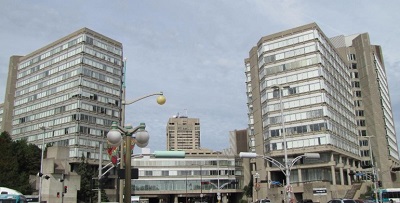Place du Portage, Phase III
Recognized Federal Heritage Building
Gatineau, Quebec

Corner of Laurier Street and Boulevard Maisonneuve
© C. Boucher and J. Dufresne, Parcs Canada | Parks Canada, 2016
Address :
11 Laurier Street, Gatineau, Quebec
Recognition Statute:
Treasury Board Policy on Management of Real Property
Designation Date:
2019-05-09
Dates:
-
1973 to 1978
(Construction)
Custodian:
Public Works and Government Services Canada
FHBRO Report Reference:
16-003
DFRP Number:
007638
Description of Historic Place
Place du Portage, Phase III (the third of the four-stage Portage Complex) is a Late Modern megastructure consisting of six connected towers that vary in height, in two stepped blocks, one on either side of Boulevard Maisonneuve—four towers to the east and two to the west, connected by a covered three-storey pedestrian bridge. Place du Portage, Phase III includes offices and commercial spaces, a three-level underground parking garage, a transportation hub (Place d’Accueil), and a hard-surfaced park (Place Aubry).
Heritage Value
Place du Portage, Phase III is a “Recognized” Federal Heritage Building because of its historical associations, and architectural and environmental values.
Historical value:
Phase III is a very good illustration of the federal government’s desire to reinforce a unified Canada at a time when Quebec nationalism was on the rise. As the third and largest of the four Place du Portage Complex phases, Phase III was part of a broader assertion of federalism expressed through the expansion of the National Capital Region to include Hull (now Gatineau) and the construction of federal buildings in Quebec. Phase III represents a period of restructuring and consolidation at the Department of Public Works (DPW) during which it began to embrace more cost-effective solutions for infrastructural challenges, while reflecting international trends in civic design such as the integration of public space. Phase III benefitted from the DPW’s Fine Arts Program, which set aside a portion of the construction budget for public art commissions. In Gatineau’s local urban context, the Complex as a whole marks a period of transformation from a sector with a strong industrial vocation to a tertiary economy dominated by public service. Construction of the Complex also led to the expropriation of neighbourhoods and the displacement of local populations, bringing about a major demographic shift and causing the demolition of much of the urban fabric of Vieux-Hull.
Architectural value:
A very good example of a Late Modern megastructure with Brutalist influences, Phase III is distinguished by its monumentality, its horizontal massing, its bold, sculptural form, and its carefully articulated details. Multi-functional and self-sufficient, Phase III acts as a node for the larger Complex. The open-concept office spaces with moveable furnishings, separate service cores, significant amounts of natural light, and views of both sides of the river were planned with the well-being of occupants in mind. Designed by the David, Boulva and Dimakopoulos consortium of architects, Phase III is a harmonious collaboration of their distinct styles, with significant attention to refinement in detail, efficiency of function, high-quality
materials, and a balance between monumental and human scales.
Environmental value:
Set in downtown Gatineau, Phase III has a strong visual presence and is tightly integrated into its urban surroundings. These include the other phases of the Complex as well as other federal, provincial, and municipal governmental buildings. Phase III serves to reinforce the Late Modern character of the area. Its monumental form dominates the city’s skyline as seen from Ottawa. With Place d’Accueil acting as a major transportation hub, Phase III serves as a symbolic gateway, marking the transition into and out of Gatineau. The largest component in the Complex, Phase III is a substantial physical landmark both day and night due to its large mass and its evening illumination.
Character-Defining Elements
The character-defining elements of Place du Portage, Phase III, that should be respected include:
Its articulation of the Late Modern style with Brutalist influences, defined by: its exposed concrete structural skeleton, both internally and externally; its sculptural silhouette with gradual setback, plays of light and shadow, repetitive use of horizontal fenestration, and carefully articulated detailing; monochromatic concrete in a variety of finishes and continuity between interior and exterior materials; built-in features such as furniture, planters, signage, as well as integrated lighting design; large bands of ribbon windows and numerous skylights providing natural light.
Its functional design, seen in: the efficient flow of space that connects a variety of interior functions to each other, to other areas of the Complex, and to the exterior; the three service cores connected to a pedestrian circulation system that fosters movement throughout the Complex; the inclusion of outdoor spaces such as Place Aubry and Place d’Accueil.
An integrated art program that includes: a fountain inside Tower E, two triptychs in Tower C, two large murals located in Place d’Accueil, and an outdoor sculpture in Place Aubry.